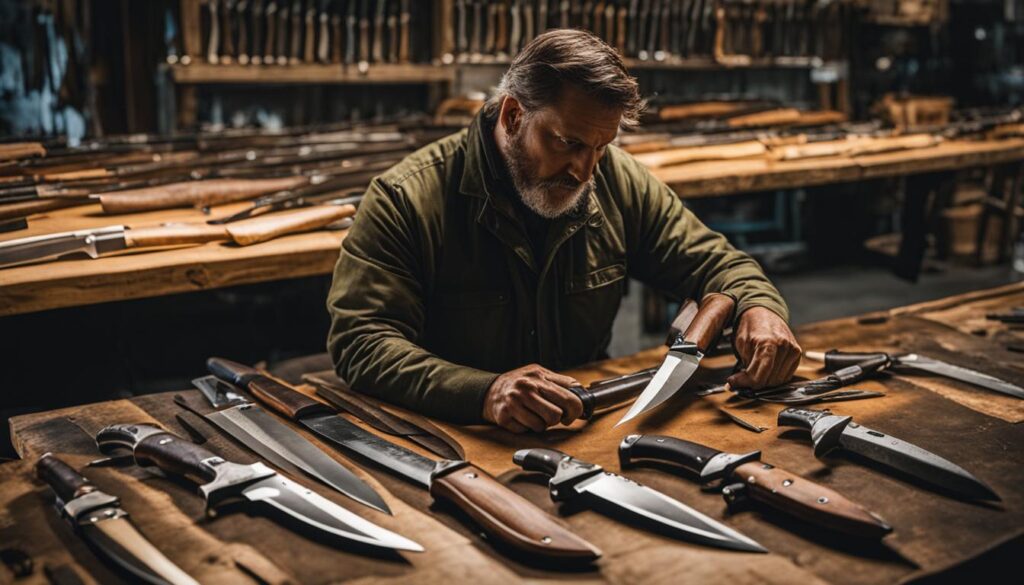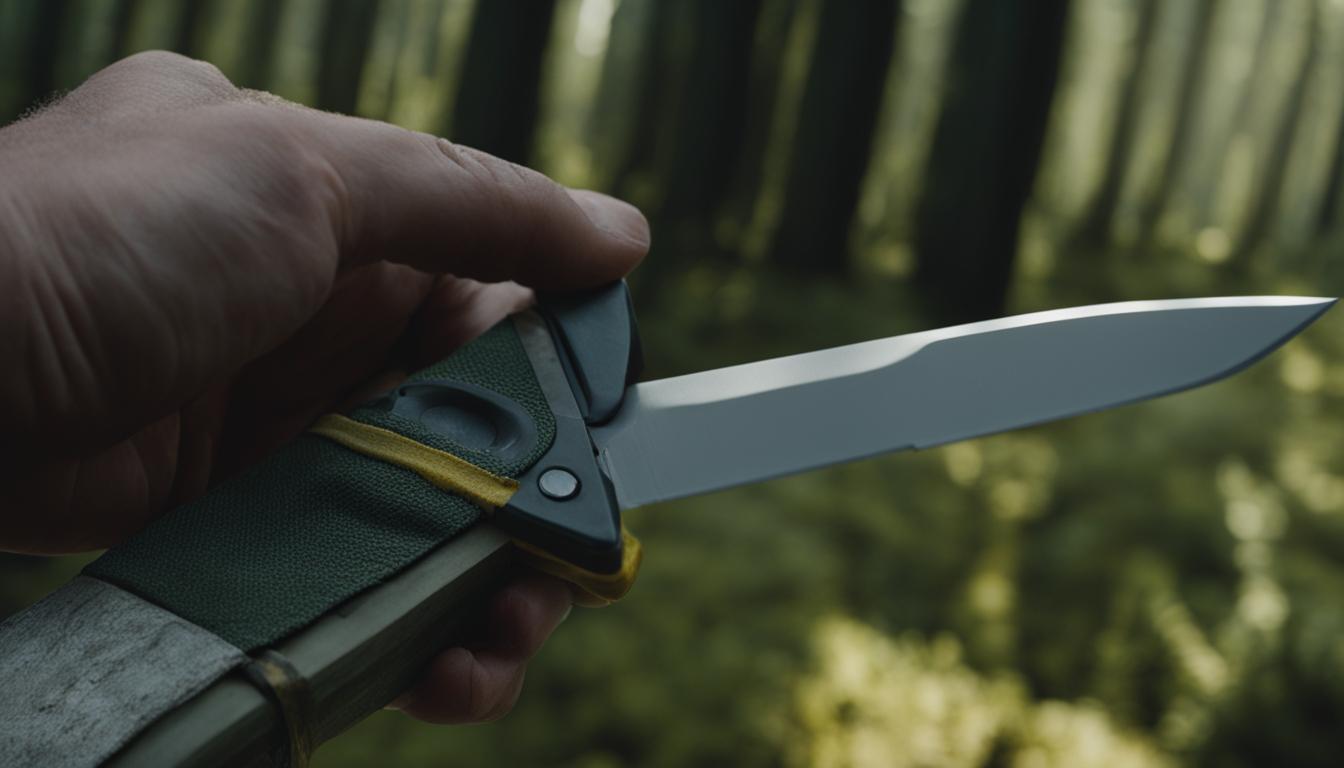When it comes to hunting knives, understanding blade length regulations is crucial for every hunter. State knife laws can vary, with some states having specific restrictions on the maximum blade length that can be carried in certain public locations. It’s essential to be aware of these regulations to ensure that you comply with the law and avoid any legal trouble.
For example, in California, blades over 4 inches long are prohibited in most public buildings, while blades over 2.5 inches long are not allowed on school campuses. Los Angeles has even stricter laws, limiting the maximum open carry blade length for the entire city to 3 inches. Similarly, in Colorado, there are no blade length restrictions for open carry knives at the state level, but certain cities within the state, like Denver, may have their own limitations.
To avoid any confusion or potential legal issues, it’s essential for hunters to research the specific knife laws in their state, as well as any state they plan to travel to. Being knowledgeable about blade length regulations will ensure that you can carry your hunting knife legally and safely.
Key Takeaways:
- State knife laws can have restrictions on the maximum blade length allowed in certain public locations.
- California prohibits blades over 4 inches long in most public buildings and blades over 2.5 inches long on school campuses.
- Los Angeles has a maximum open carry blade length limit of 3 inches for the entire city.
- Colorado does not have blade length restrictions at the state level, but some cities, like Denver, may have their own limitations.
- Hunters should research and understand the specific knife laws in their state and any state they plan to travel to.
Overall Length Restrictions and Legal Concealed Carry Length
When it comes to hunting knives, it’s not just the blade length that hunters need to consider. Some states have laws that include restrictions on the overall length of the knife that can be carried. For example, Texas allows any length knife to be carried openly or concealed in general, but there are limitations on the overall knife length in certain locations such as schools, polling places, sporting events, bars, and amusement parks. These restrictions aim to ensure public safety and prevent the misuse of knives in crowded or sensitive environments.
The legal concealed carry length for knives varies from state to state. In Arkansas, for instance, there are no length restrictions for open or concealed carry knives at the state level. However, it’s important to note that certain cities within Arkansas may have their own stricter laws. On the other hand, Arizona has no specific length restrictions for open or concealed carry knives and also has a statewide preemption that prevents local governments from imposing more restrictive prohibitions.
Understanding the overall length restrictions and legal concealed carry length in your state is crucial to avoid any legal issues while hunting or carrying a knife. It’s important to stay informed about the specific laws in your state and any state you plan to travel to. This knowledge will help ensure that you comply with the regulations and can enjoy your hunting activities confidently and within the bounds of the law.
The Importance of Compliance
Non-compliance with knife laws can result in severe consequences, including fines, confiscation of knives, and even criminal charges. It’s essential for hunters to be aware of and adhere to the overall length restrictions and legal concealed carry length in their state. By doing so, hunters can ensure they are carrying their knives legally and safely, while also promoting responsible knife ownership and usage.
| State | Overall Length Restrictions | Legal Concealed Carry Length |
|---|---|---|
| Texas | Limits overall knife length in certain locations | Varies depending on location |
| Arkansas | No state-level length restrictions | No state-level restrictions |
| Arizona | No state-level length restrictions | No state-level restrictions |
Table: Overall Length Restrictions and Legal Concealed Carry Length in Select States
Types of Knives and Additional Restrictions
Aside from blade length regulations, hunters should also be aware of restrictions on certain types of knives. Switchblades, for example, are illegal in some states regardless of their length. In Montana, residents can carry any type of knife, including switchblades, while in states with more restrictive laws, switchblades are prohibited. Additionally, some states have restrictions on carrying dirks, daggers, or concealed knives. New York City, in particular, has strict laws regarding concealed knife carry. It’s important for hunters to research and understand the specific types of knives that are legal to carry in their state to avoid legal trouble.
“Switchblades are illegal in some states regardless of their length.”
While switchblades are prohibited in certain states, other types of knives may be subject to additional restrictions as well. Some states, for instance, have laws regarding carrying dirks, which are defined as knives typically used for stabbing, and daggers, which have two sharp edges. Concealed knives, which can be disguised as innocent objects like pens or combs, are also subject to regulations in certain jurisdictions. Hunters should familiarize themselves with the specific laws and definitions in their state to ensure they comply with all restrictions.
To illustrate the varying laws on knife types, the table below provides an overview of the legality of switchblades, dirks, daggers, and concealed knives in a selection of states:
| State | Switchblades | Dirks | Daggers | Concealed Knives |
|---|---|---|---|---|
| Montana | Legal | Legal | Legal | Legal |
| New York | Illegal | Illegal | Illegal | Illegal |
| Texas | Legal | Legal | Legal | Legal |
| California | Illegal | Illegal | Illegal | Illegal |
As shown in the table, the legality of switchblades, dirks, daggers, and concealed knives varies across different states. It is crucial for hunters to understand the laws specific to their state and any state they plan to travel to in order to avoid legal complications.
Summary:
Understanding the types of knives that are legal to carry is an important aspect of compliance with knife laws. Switchblades are prohibited in some states, and other types of knives, such as dirks, daggers, and concealed knives, may be subject to additional restrictions. Hunters must be aware of the specific laws regarding these types of knives in their state and any state they plan to visit. By researching and understanding the regulations, hunters can ensure they carry knives that are legal and avoid potential legal pitfalls.
Considerations for Choosing the Right Hunting Knife
When it comes to selecting a hunting knife, there are several important factors that hunters should consider. From the size and type of blade to the handle material and blade style, each aspect plays a crucial role in determining the functionality and effectiveness of the knife. To help hunters make an informed decision, here are some key considerations to keep in mind when choosing the right hunting knife.
Blade Size and Type
The size of the blade is an important factor to consider when selecting a hunting knife. For general hunting tasks, it is recommended to choose a knife with a blade length of around 4 inches or less. However, if you plan to hunt larger game, a longer blade may be more suitable. Additionally, hunters should consider the type of blade they prefer. Some common blade types include drop point, clip point, and trailing point. Each blade style offers different advantages and is best suited for specific tasks such as skinning, gutting, or general-purpose use.
Fixed Blade vs. Folding Knife
Another decision hunters need to make is whether to choose a fixed blade or a folding knife. Fixed blade knives are generally more rugged and reliable, making them well-suited for heavy-duty tasks. They are also easier to clean and maintain. On the other hand, folding knives offer convenience and easier portability. They can be compactly folded and stored when not in use, making them a popular choice for hunters who value versatility and ease of carry.
Handle Material and Blade Quality
The handle of the hunting knife should be comfortable to hold and provide a secure grip. Common handle materials include wood, plastic, rubber, and various types of composites. It’s important to choose a material that offers both durability and grip, even when wet. Additionally, the quality of the blade should not be overlooked. High carbon steel and stain-free high carbon steel are popular choices due to their durability and resistance to corrosion. Ultimately, the blade material should be selected based on the specific needs and preferences of the hunter.
Sheath Design and Accessories
Lastly, hunters should consider the sheath design and any additional accessories that come with the hunting knife. The sheath should be lightweight, durable, and securely hold the knife while in motion. It should also provide easy access to the knife when needed. Some hunting knives may come with additional accessories such as a sharpening stone, fire starter, or gut hook. These accessories can enhance the functionality and convenience of the knife, so it’s worth considering if they align with your hunting needs.

By carefully considering these factors, hunters can choose a hunting knife that best suits their specific needs and preferences. Whether you value durability, portability, or versatility, there is a wide range of hunting knives available on the market to cater to different hunting styles and requirements. Remember to research and compare different options, read reviews, and seek recommendations from experienced hunters to ensure you make the right choice for your hunting adventures.
Conclusion
Understanding blade length regulations and other knife laws is essential for hunters like myself to ensure we are carrying our knives legally and safely. State knife laws can vary, with some states imposing restrictions on blade length, overall knife length, and concealed carry length. It’s important for us to research and understand the specific knife laws in our state and any state we plan to travel to.
In addition to blade length regulations, we should also consider the legal restrictions on certain types of knives. Switchblades, for example, are illegal in some states regardless of their length. Knowing the specific types of knives that are legal to carry in our state can help us avoid legal trouble.
When choosing a hunting knife, we need to consider various factors. We should think about the game we will be hunting, how often we hunt, and how we will be using the knife after the harvest. Factors like blade size, handle material, blade material, and blade style should all be taken into account.
By being knowledgeable about blade length regulations and making informed choices when selecting a hunting knife, we can ensure that we are abiding by the law and have a reliable tool for our outdoor pursuits. It’s important to prioritize legal considerations and choose the right hunting knife that meets our specific needs as responsible hunters.
FAQ
Are there specific blade length restrictions for hunting knives?
In most states, there are no general restrictions on blade length for hunting knives. However, certain public locations may have limitations on the maximum blade length that can be carried.
What are the blade length restrictions in California?
California prohibits blades over 4 inches long in most public buildings and blades over 2.5 inches long on school campuses. Los Angeles has its own more restrictive laws, setting the maximum open carry blade length for the entire city at 3 inches.
Do all states have blade length restrictions for hunting knives?
No, some states, like Colorado, do not have restrictions on the blade length of open carry knives at the state level. However, certain cities within the state, such as Denver, may have their own limitations.
Are there overall length restrictions for hunting knives?
Yes, some states limit the overall length of the knife that can be carried in certain locations such as schools, polling places, sporting events, bars, and amusement parks. For example, Texas limits overall knife length to 5.5 inches in these locations.
What is the legal concealed carry length for knives?
The legal concealed carry length for knives varies from state to state. Arkansas, for instance, has no length restrictions for open or concealed carry knives at the state level, but some cities within Arkansas may have stricter laws.
Are switchblades legal for hunting?
Switchblades are illegal in some states regardless of their length. Montana, for example, allows residents to carry any type of knife, including switchblades, while states with more restrictive laws prohibit them.
What types of knives may have additional restrictions?
Some states have restrictions on carrying dirks, daggers, or concealed knives. New York City, in particular, has strict laws regarding concealed knife carry.
What factors should I consider when choosing a hunting knife?
Factors to consider include the game being hunted, frequency of hunting, and intended use of the knife after the harvest. Blade size, handle material, blade material, and blade style should also be taken into account.
Should I choose a fixed blade or folding blade hunting knife?
Fixed blade knives are generally more rugged and reliable, while folding knives offer convenience and easier transport. The choice depends on personal preference and the specific tasks the knife will be used for.
What are some popular blade materials for hunting knives?
High carbon steel and stain-free high carbon steel are popular options for blade material.
What should I consider when selecting a hunting knife sheath?
The sheath should be lightweight, durable, and securely hold the knife while in motion.





